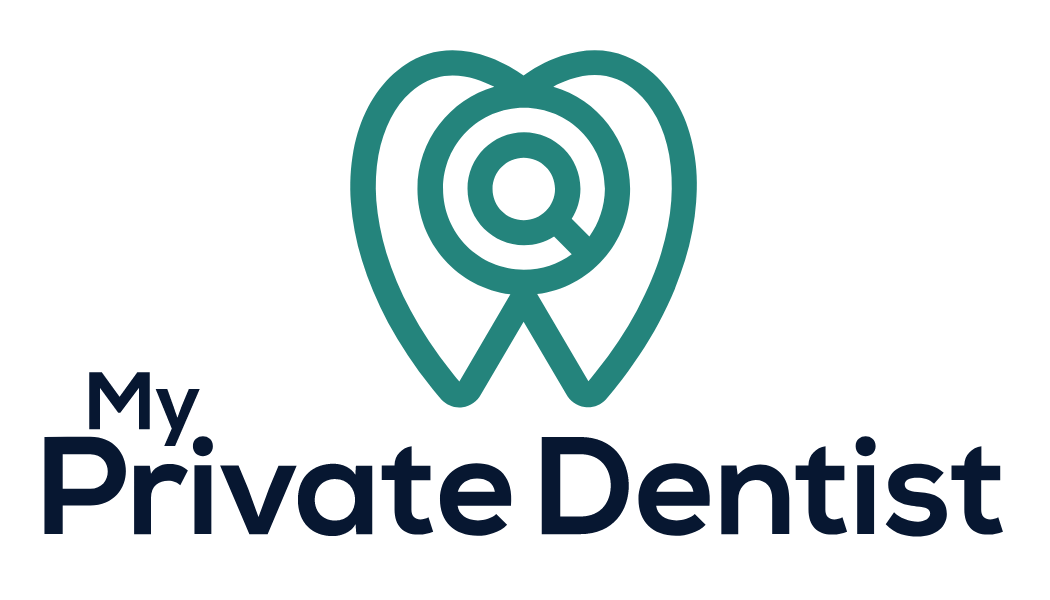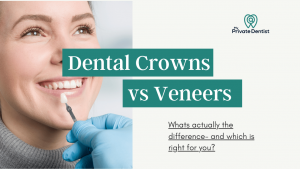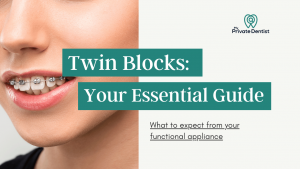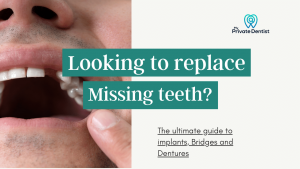How much does teeth whitening cost in the UK?
There are three main types of tooth whitening available;
Home whitening kits cost from £20 – £100
Professional whitening treatments cost from £250 – £500
Laser whitening treatments can cost from £500 – £1000
As a dentist, I have many patients interested in teeth whitening to brighten their smile. They want to know about the process, and the costs involved in professional teeth whitening.
Other patients ask about cheaper alternatives such as whitening toothpastes, or home whitening kits that are available online or in stores, and want to know if they are effective.
In this article, I aim to explain the different methods of tooth whitening available in the UK, as well as tips on how to choose the right method for your needs and budget.
But first…
Why is there such a difference in the teeth whitening cost in the UK?
The cost of teeth whitening depends on 3 main factors:
- The method of whitening treatment,
- The strength, or concentration, of the whitening agent
- The level of professional time and expertise required
In general, the more clinical time required by the dentist to carry out the whitening procedure, the more expensive it is likely to be. Home whitening kits are usually cheaper and bought online, or at a pharmacy.
Professional teeth whitening methods have a much higher concentration of bleaching agent compared to store bought whitening gels.
In the UK any over-the-counter whitening products, including home whitening kits and whitening toothpastes, are limited to a maximum concentration of 0.1% Hydrogen Peroxide. They also come with a mass-produced one-size-fits-all tray system which can be mass produced. These trays are unlikely to be well-fitting, and can cause potential irritation to gums, or uneven results.
In comparison, dentists can prescribe whitening gel with a concentration of up to 6% hydrogen peroxide (60x stronger), which is much more effective. Well-fitting custom whitening trays are provided to ensure safe and even application of the bleaching gel. This makes professional treatment more expensive.
It is important to note, a dentist will make an assessment of the patient’s dental health and make sure they are suitable for teeth whitening before prescribing whitening treatment.
Laser or LED in-clinic whitening treatments are the most expensive option as they require a dental professional and clinical surgery time. These treatments use a stronger concentration of the active ingredient and can produce the fastest and most dramatic results.
What other factors affect teeth whitening cost?
The price of professional whitening treatment depends on:
- The location of the dental practice
- The experience of the dentist
- The type of bleaching agent used, and the amount of whitening gel syringes provided
- Promise of a shade guarantee. Brands such as Boutique and Enlighten offer a B1 Shade guarantee. These packages are more expensive but you receive as many syringes of whitening gel you need to achieve a particular shade.
- Whether the practice independently owned or part of a larger chain
With so many factors affecting teeth whitening cost, it’s important to understand what you’re getting for your money before committing to a treatment.
What’s the best way to whiten your teeth?
The best way to whiten your teeth, and the method I used for myself and my patients, is professional bleaching treatment.
What is professional tooth whitening treatment?
Also known as professional bleaching treatment, it is an effective method of whitening using bleaching gels in custom fit trays. A dentist takes impressions of your teeth to make closely fitting trays, with special small pockets or reservoirs on the front surface, which allow room for the bleaching agent to come in contact with your teeth. Whitening gel is provided in syringes, which you apply into the tray and then place over your teeth like a mouthguard.
On average, using this method daily for 2-4 weeks will lead to lighter and brighter teeth. If your teeth are more stained the process may take longer.
Professional Bleaching Treatment with high concentration bleach can only be carried out by a certified dental professional.
Am I suitable for tooth whitening?
A dentist can assess whether you are suitable for professional tooth whitening;
- You must be over 18 for tooth whitening.
- You should have healthy teeth and gums.
- They will ask you about tooth sensitivity to cold drinks etc. before deciding which bleach to prescribe you. You may need to use a sensitive toothpaste for a while before treatment.
- Whitening is not recommended if you are pregnant or breastfeeding.
- Teeth whitening only works on natural tooth tissue. If you have front crowns, veneers, bridges or implants you may not be suitable for whitening. The dentist can discuss alternative options for you.
How does the bleach whiten the teeth?
The bleaching agent used in teeth whitening gel is either hydrogen peroxide or carbamide peroxide. Peroxide releases oxygen free-radicals when it comes in contact with the tooth surface.
These free-radicals penetrate the enamel and dentine layers of the tooth and break down the chromophore molecules that cause discolouration and staining. This process leads to the removal of larger stain particles and the creation of smaller ones, making the teeth appear whiter and brighter.
The effectiveness of bleach depends on the nature and severity of the stains. Yellow and brown stains caused by certain foods, or tobacco products are easier to remove than deep-seated grey or brown stains caused by injury, aging, or certain medications. In some cases, multiple bleaching sessions or other dental procedures may be required to achieve optimal results.
Extrinsic vs Intrinsic Staining: Does polishing remove all the stains from my teeth?
To answer this question we need to look at the two different types of staining.
Extrinsic stains: Are on the surface of your teeth, and caused by tobacco smoking, poor oral hygiene and certain drinks e.g. coffee and red wine. This type of stain can be removed by brushing well with an electric toothbrush and visiting the dentist or hygienist regularly for a polish.
Intrinsic stains: Are embedded inside the enamel of your teeth and show through. These occur over time and are caused by trauma, ageing and genetic factors. These cannot be polished away and require bleaching to dissolve through the surface to break down the stain.
Find out how to remove stains from teeth.
What are the types of bleach available?
There are two main types of bleach available; these are both equivalent in strength but work in different ways:
Hydrogen peroxide 6% – This is typically worn for one hour a day for two weeks. It is very effective in custom trays but can make your teeth sensitive.
Carbamide Peroxide 16% – This is to be worn for 4-6 hours as is slow release. Usually overnight, again for two weeks. Carbamide Peroxide takes longer before you see results, but it is suited for patients with mild sensitivity.
Carbamide Peroxide 10% – To be worn usually overnight also. Milder than 16% so takes longer to work but better for patients with moderate sensitivity.
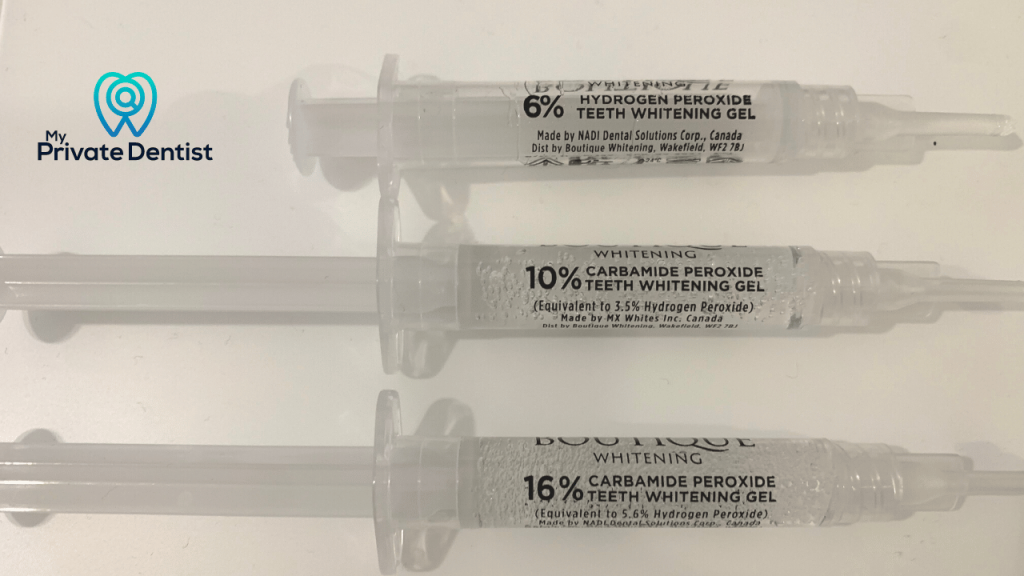
Which is the best bleach for me?
This is a personal choice depending on lifestyle. Some people prefer to use the hydrogen peroxide 6% for 1 hour each day. Others prefer to wear their trays overnight, and therefore opt for carbamide peroxide 16%.
If you suffer from sensitivity, the gentler method of using carbamide peroxide overnight would be recommended to you. There is also a 10% carbamide peroxide available which is milder, which will again take longer but for patients with more sensitive teeth.
Step by Step Guide: What is the exact process of Professional Tooth whitening?
First Appointment
- Assessment: A dentist will check your whole mouth to make sure everything is healthy and see whether whitening would work well for you.
- Sensitivity check: They will then ask you some questions on how your teeth react to cold drinks, and levels of gum recession. This will help the dentist decide which type of whitening gel will be the most comfortable for you.
- Initial Shade: A shade guide will be used to verify which shade your teeth currently are. This can help show you how well your treatment has worked. A photo will be taken with the shade tab next to your tooth.
- Impressions: Alginate impression material will be used to take an accurate mould of your upper and lower teeth. These are sent to a labaratory who make your custom fitted trays.
- Sensitive/Biomineralising toothpaste: The dentist will provide you with a special desensitising toothpaste to use for 2 weeks before fitting your whitening trays. This should help to reduce sensitivity when you have your whitening treatment.
Second Appointment
- Try in trays: The custom trays will be tried in and checked for a close fit. They should fit with close contact to your teeth to avoid bleach overflowing
- Demonstration: The dentist will demonstrate how to load the trays with the whitening gel. They will emphasise the importance of not overfilling the trays, which can lead to irritation of gums.
- First Application: You should use gauze to dry your teeth, as moisture can reduce the effectiveness of the whitening gel. The pre-loaded trays are then inserted in to your mouth. You will be given your whitening pack and any other instructions you may need.
- Tray removal: After leaving the clinic, you should leave the trays in for at least one hour. They can then be removed, and you should brush your teeth. Clean your trays with cold water and a soft toothbrush and leave to fully dry before re-using.
Third Appointment – Review
- Your experience: the dentist will ask you how you found the process and ask about any sensitivity you may have had. Also discuss with you how you feel about the results. Note, patients often experience some mild sensitivity, which reaches its peak at day 3 of whitening.
- Further whitening: If you would like to whiten your teeth further they may offer you some top up syringes
- Post whitening shade check – The shade guide will again be used to assess how the colour of the teeth have changed with the treatment. Another photo will be taken for your clinical notes.
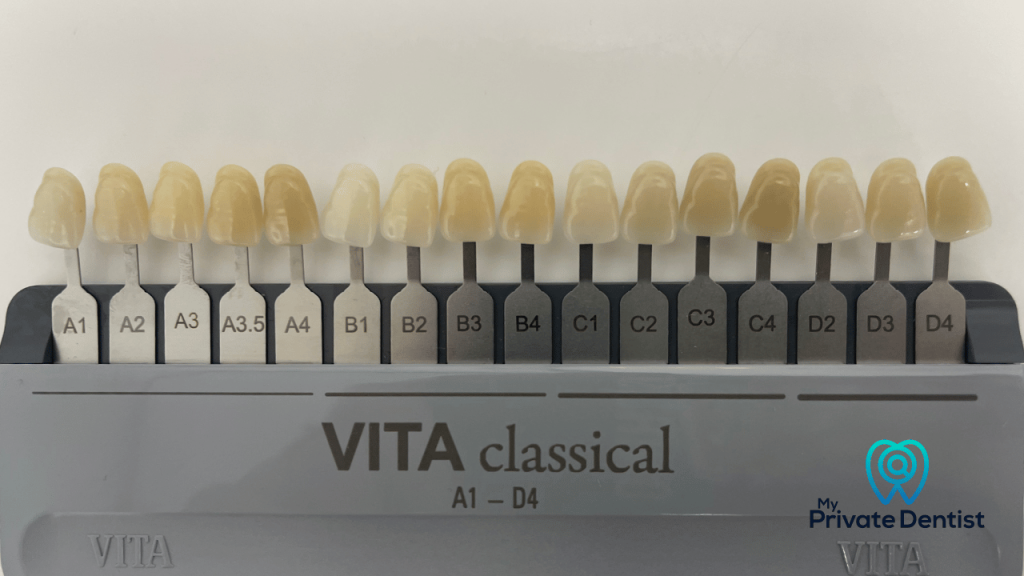
How long does tooth whitening last?
The whitening effect lasts around 3 years but is dependent on dietary and lifestyle factors. It will last longer if:
- You avoid staining foods and drinks such as coffee and red wine.
- You don’t smoke
- You brush your teeth twice a day with an electric toothbrush.
- You visit the dentist or hygienist regularly for a scale and polish
You should keep your custom trays safe. If you would like to top up your whitening can purchase further syringes as and when needed. The price of these top ups range from £15-£30 per syringe.
Top tips for tooth whitening
Drying the trays: Use a cotton bud to dry each tooth area in the whitening tray. The drier your teeth and trays are the better the whitening will work
Protect the gel from air: Make sure you replace the lids on the syringes when not using them. If not the end portion of gel will oxidise and not be effective.
Syringe storage: Make sure the whitening gel is stored in a dry place away from direct sunlight. Keeping them in the fridge keeps the gel stable.
What is Laser Tooth Whitening? Is it worth it?
Sometimes known as LED or Power teeth whitening, it is the most expensive but fastest method of whitening your teeth.
- It is provided in the dental clinic setting.
- The dentist will assess your teeth. It is not suitable for patients who suffer from sensitivity.
- A dental guard is used to keep your mouth open and teeth dry.
- A hard setting paste is used to cover over your gums to protect them from the bleach.
- The whitening gel is then coated onto the outer tooth surfaces
- A bright blue light is used to shine onto the teeth to activate the gel and speed up the whitening process. This is typically left for one hour.
- At the end of the process, the dentist washes off the gel and gives your teeth a polish
Advantages of laser tooth whitening:
- Quick results
- Controlled environment so you can’t ‘do it wrong’
Disadvantages of laser tooth whitening:
- More expensive, can cost between £500-£1000
- Can lead to increased sensitivity
- Usually used in combination with professional home whitening anyway
Are cheaper home kits just as effective professional whitening?
Home kits are very popular on the internet right now. They start from around £20 and can be sold for as high as £100.
You can get some degree of whitening if they are used carefully and consistently.
- Brush and dry your teeth.
- Paint the gel onto your tooth surface without getting any onto your gums.
- Bite on the tray and keep your mouth open to keep your teeth dry.
- Some come with a tray which has a blue light to activate the gel.
- Recommended for 20 minutes daily use for 2-3 weeks.
Advantages of Home whitening kits
- Cheaper than professional whitening
- No need to visit a dentist
- Can be ordered straight to your home
Disadvantage of Home whitening kits
- They cannot contain more than 0.1% hydrogen peroxide therefore are not as effective as professional bleaching at removing intrinsic staining.
- They come with one size trays which are unlikely to hold the bleach effectively against the teeth.
- Technique sensitive, have to apply carefully as to not irritate gums or swallow.
What is the cheapest way to whiten your teeth?
You can buy whitening toothpastes over the counter from most pharmacies and supermarkets. They are good at removing extrinsic stains and keep your teeth white. As they cannot contain more than 0.1% hydrogen peroxide they are not effective in removing any intrinsic staining or brightening the shade of your teeth.
Is teeth whitening covered on the NHS?
Generally teeth whitening cost is not covered under the NHS as it is a cosmetic procedure.
One case where it may be used is if you have a single discoloured tooth due to trauma, where the tooth has devitalised. In these cases internal and external bleaching may be used to improve the appearance of a tooth following root canal treatment [1].
This is covered on a band 3 NHS charge, as it requires lab made trays.
Is teeth whitening cost covered on a dental plan?
Cosmetic work is often not covered on dental plans. However some practices may offer a discount of 10-20% on teeth whitening for patients who have a plan in place.
What should I do now?
If you’re looking for professional tooth whitening, find a dentist who can help you with this today.
